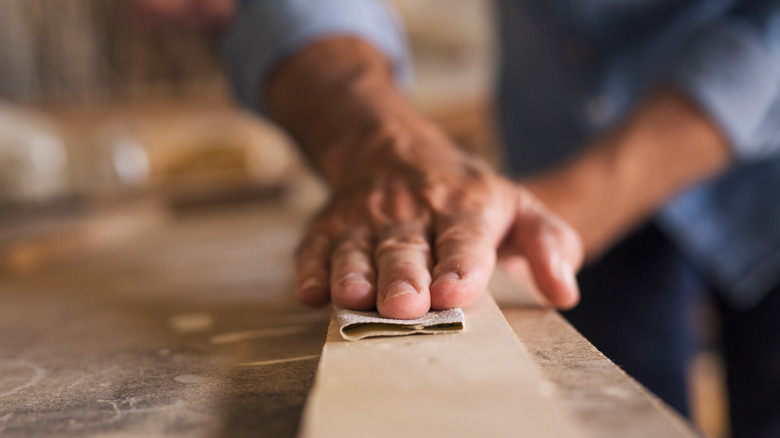The Most Important Place To Use Sandpaper That You're Probably Missing
When you think of sandpaper, you probably think back to your first high school shop class, where you used the material to smooth the edges of wood. However, there are actually dozens of uses for the handy abrasive that don't involve your 10th-grade midterm project. Sandpaper is an all-star when it comes to household maintenance and do-it-yourself projects. Reader's Digest Canada touts its ability to hone scissors and sewing needles. Do your pencils need sharpening? Sandpaper or emery board to the rescue. Sandpaper also comes in handy when preparing wood for painting or staining, and sanding is a practical way to remove old paint.
Using abrasives for smoothing and polishing is as old as the Pyramids, and sandpaper itself dates to 13th century China. Shells, seeds, and sand, all held together with gum, provided the abrasive power of the first sandpaper. Sandpaper has been mass-produced in the U.S. since the 1830s. Commonly used ingredients now include garnet, emery, aluminum oxide, and silicon carbide. Texture ranges from smooth to coarse, with low grit content to high, so you can select which is best for your project.
Make steps slip-free by adhering sheets of sandpaper to them. Getting a grip using sandpaper on stuck-on jar lids removes them easily. You can restore and maintain wooden cutting boards with a once-a-year sanding. Sandpaper can be used to remove rust from cast iron pans and pots.
Unique uses
Sandpaper has several other practical applications. You can also treat flaws in clothing using sandpaper — from catching sweaters' fuzz balls to remedying scuff marks on suede. If your shoe's sole is slippery, you can rough them up with sandpaper for a safer stroll.
You can even make intractable grout stains look better. Restoration Master suggests folding a rough piece of the abrasive to form an edge. Scrape grout with it to remove grime, then wipe using a dry rag. Steer clear of tiles to avoid scratching them, and don't use a mechanical sander.
If your cat scratches or sprays your furniture, the ASPCA says you can thwart it by wrapping sandpaper around furniture legs. By making a sandpaper barricade on the ground, it can also be used to block pests like slugs from entering your garden. Speaking of gardens, Tips and Tricks recommends using sandpaper to scrape away seeds' outer layers before planting to encourage successful growth.
Get creative
Sandpaper has a supporting role in many arts and crafts projects. Its use is limited only by one's imagination. A sandpaper-printed T-shirt is a great idea suggested by Alpha Mom. Create a design using crayons on sandpaper. Grittier paper will yield a more textured result. Place sandpaper face-down on a T-shirt (first inserting cardboard inside to prevent coloring its back). Place a protective paper on top of the sandpaper and iron it for half a minute. You will have transferred a colorful, textured design to your T-shirt! To set and get rid of excess crayon wax, cover the design with paper and iron. Then place T-shirt in dryer. As an alternative, sandpaper art can be created on a piece of construction paper.
No matter what you decide to do with your sandpaper, always practice appropriate safety measures. Sawdust and other particles can become airborne and pose hazards. Wearing gloves, donning protective eyewear, and using dust masks might be proper precautions. Avoid wearing polyester or other flammable fabrics if sanding is apt to generate sparks.


